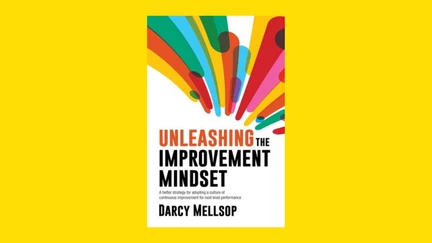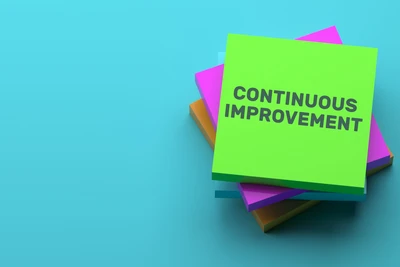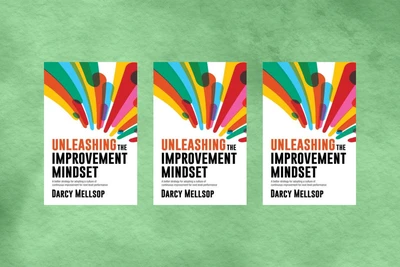Guest post: Unleashing the Improvement Mindset - a Game-Changer for Leaders

Darcy Mellsop is a seasoned expert in continuous improvement, leadership, and organisational change. With a background in helping teams across industries unlock their improvement potential, he has dedicated his career to making performance improvement simple, sustainable, and impactful. His work is driven by a passion for empowering leaders to create high-performance environments where teams thrive. Unleashing the improvement mindset : a better strategy for adopting a culture of continuous improvement for next level performance reflects his wealth of experience and commitment to making continuous improvement an everyday reality for organisations everywhere.
Unleashing the Improvement Mindset: A Game-Changer for Leaders
In today’s dynamic business environment, the ability to continuously improve is strong competitive advantage. Yet, many organisations struggle to embed a true culture of continuous improvement. They get bogged down by complex methodologies, over-engineered processes, and slow-moving change initiatives that fail to gain traction.
Unleashing the improvement mindset was written to provide a practical, no-nonsense guide that empowers leaders to create an environment where improvement is not a one-time initiative but an ingrained mindset. This book provides a clear roadmap for embedding a culture of continuous improvement, ensuring that organisations move beyond quick fixes and develop the long-term capability to perform better, faster, and more productively and efficiently.
Why Leaders Should Read This Book
For leaders, Unleashing the Improvement Mindset is not just another business book; it’s a powerful tool to ignite meaningful change. I make the argument that too many teams get stuck in the weeds of problem-solving without ever addressing the root causes. A refreshingly simple yet effective Two-Loop Approach is presented that ensures improvement is embedded at a cultural level, not just as an initiative.
The book provides a blueprint for leaders to:
- Create lasting change by fostering a mindset of continuous improvement over relying on rigid methodologies.
- Avoid common pitfalls such as slow progress, overwhelming complexity, and underwhelming results.
- Engage and empower teams by building their capability to solve problems at the root, quickly and effectively.
- Experience significant and tangible results while preparing for deeper, more complex improvements in the long run.
One of the key messages in the book is that improvement should not be daunting or overly complicated. We need to start somewhere, we need to start simply, and we need to start by generating results. By focusing on quick wins early on, organisations can build momentum and an appetite for continuous improvement.

Key Insights from the Book
- The Two-Loop Approach: Start Smart, Then Go Deep
The book introduces a structured yet flexible method for embedding continuous improvement:
- Loop 1: Focuses on simple, high-impact improvements that quickly demonstrate value. This keeps teams engaged and builds confidence in the process.
- Loop 2: Enables organisations to tackle more complex, deep-seated performance issues, refining their problem-solving skills over time.
By breaking the adoption of continuous improvement into these two loops, teams avoid the common trap of trying to solve everything (and the biggest things) at once and becoming overwhelmed.
2. Problems Are a Good Thing—If You Solve Them
One of the most compelling ideas in the book is that leaders should embrace problems rather than fear them. Problems are useful because they indicate exactly where a solution can be applied for better performance.
Too many organisations hide or ignore problems, fearing they will expose weaknesses. However, successful companies see problems as opportunities to improve. Leaders must create a culture where issues are surfaced early, addressed quickly, and used as stepping stones for continuous learning.
3. Performance Is About Capability, Not Just Effort
A key distinction the book makes is that high performance does not come from working harder, but from creating an environment where work is easier. This is illustrated through a powerful analogy:
"Having a team perform at a mediocre level takes the same energy as a team performing with excellence. The difference is in how that energy is used."
Instead of continually firefighting inefficiencies, organisations should focus on fixing root causes and designing smarter ways of working. This frees up capacity for strategic initiatives rather than just keeping up with day-to-day demands.
4. Leaders Need Courage to Drive Change
Continuous improvement takes more than just good intentions—it requires courage. Leaders must be willing to:
- Look at why their organisation is underperforming, even when the answers are uncomfortable.
- Challenge conventional wisdom and outdated processes, rather than maintaining the status quo.
- Make decisions based on data rather than assumptions.
- Empower their teams to take ownership of improvement, rather than dictating every step.
To put it bluntly:
"Courage is the single most valuable element that is needed to support continuous improvement in an organisational culture."
Real-World Impact: The Power of Small, Smart Changes
The book provides numerous examples of how small but strategic improvements have driven remarkable results in real organisations. Some highlights include:
- Reducing a customer service queue from 120 days to under an hour, saving $1.29 million per year.
- Cutting report writing time from 142 minutes to 52 minutes, reclaiming nearly 4,000 hours of capacity annually.
- Improving first-time resolution in customer service calls from 0% to 100%, reducing unnecessary follow-ups and freeing up team capacity.
These examples reinforce the book’s central message: Improvement doesn’t need to be radical—it just needs to be consistent and purposeful.
A Book That Challenges, Inspires, and Equips Leaders
Unleashing the Improvement Mindset is not just a book about making processes better; it’s about transforming the way organisations think about improvement. It’s about enabling teams to take ownership, work smarter, and create a culture where improvement becomes second nature.
For leaders at all levels—whether they’re seasoned executives or frontline managers—this book provides the practical tools and mindset shifts needed to drive meaningful change. It encourages leaders to move away from reactive problem-solving and towards proactive, strategic improvement.
"Continuous improvement is about ensuring we are not carrying today’s problems into tomorrow—it’s about making life easier for your team and your customers."
If you’re looking to stop firefighting and start making real, lasting improvements, this book is an essential read.
